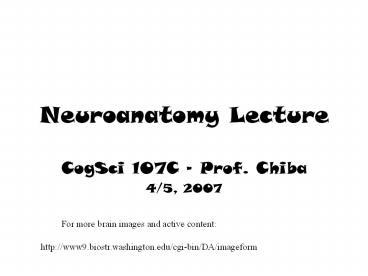Neuroanatomy Lecture PowerPoint PPT Presentation
Title: Neuroanatomy Lecture
1
Neuroanatomy Lecture
- CogSci 107C Prof. Chiba
- 4/5, 2007
For more brain images and active content
http//www9.biostr.washington.edu/cgi-bin/DA/image
form
2
This is your brain.. (no, really)
3
Central Nervous System
4
Sulci and Fissures
5
External Brainstem Cranial Nerves
6
On Old Olympus Towering Top A Finn And German
Viewed Some Hops.
7
Example of Cranial Nerve Trigeminal
The trigeminal nerve as the name indicates is
composed of three large branches. They are the
ophthalmic (V1, sensory), maxillary (V2, sensory)
and mandibular (V3, motor and sensory) branches.
8
Ventricles
9
(No Transcript)
10
Blood Supply
11
(No Transcript)
12
Blood Vessels
13
Sagittal Brainstem
14
Limbic System
15
Medial Structures
16
Hippocampus
17
Hippocampal Dissections
18
Thalamus
19
Corona Radiata Thalamic Pathways
20
Caudate Nucleus
21
Basal Ganglia Structures
22
Cortex
23
Cerebellum
24
Vascular System
- Reminder All brain function is dependent on
oxygen. - There are two main arterial supplies to the
brain - Carotid Arteries
- Basilar Artery (comes off of vertebral arteries)
25
(No Transcript)
26
(No Transcript)
27
Vertebal Arteries/Basilar Artery
Identify the following arteries in the cerebral
angiogram in the image above Vertebral Artery -
Basilar Artery
28
Right Internal Carotid Artery
29
(No Transcript)
30
(No Transcript)
31
(No Transcript)
32
(No Transcript)
33
DA, NE, 5HT Pathways
34
Norepinephrine
35
The Origins of Cognitive Neuroscience
Psychology Experimental/Cognitive Neurology
Clinical Emergent Clinical Fields Behavioral
Neurology Neuropsychology Emergent Experimental
Fields Neuroscience Experimental
Neuropsychology Behavioral Neuroscience
36
Research Populations
- Human patients with brain damage or disorders
- Neurologically intact humans
- Nonhuman animals
- primates
- rodents
- invertebrates
37
The Origins of Cognitive Neuroscience
- Psychology Experimental/Cognitive
- Neurology Clinical
- Emergent Clinical Fields
- Behavioral Neurology
- Neuropsychology
- Emergent Experimental Fields
- Neuroscience
- Experimental Neuropsychology
- Behavioral Neuroscience
38
Research Populations
- Human patients with brain damage or disorders
- Neurologically intact humans
- Nonhuman animals
- primates
- rodents
- invertebrates
39
Patients with Brain Damage
- The lesion approach
- Examples 1. HM
- remember him???
- 2. Blindsight
- huh?
- Any problems with this approach???????
40
WHAT'S NEW WITH THE AMNESIC PATIENT H.M.?
Suzanne Corkin H.M. became amnesic in 1953.
Since that time, nearly 100 investigators, first
at the Montreal Neurological Institute and since
1966 at the Massachusetts Institute of
Technology, have participated in studying him. We
all understand the rare opportunity we have had
to work with him, and we are grateful for his
dedication to research. He has taught us a great
deal about the cognitive and neural organization
of memory. We are in his debt.
41
(No Transcript)
42
Problems with the Lesion Approach
- Variability in regions of damage
- Example language mapping
43
BTW DISCLAIMER
- The broken brain may not process information in
the same way as the intact brain.. - EG Stiles developmental studies of spatial
processing
44
Behavioral Methods
- Clinical Interviews
- Information from caretakers
- Neuropsychological Testing
- Battery Approach
- Decision Tree Approach
- Experimental Testing
45
(No Transcript)
46
(No Transcript)
47
(No Transcript)
48
(No Transcript)
49
(No Transcript)
50
Physiological Methods
- CAT Computerized Axial Tomography
- MRI Magnetic Resonance Imaging
- FMRI
- PET
- Electrophysiological Recording
- EEG
- ERP
- Depth Electrodes
51
(No Transcript)
52
(No Transcript)
53
(No Transcript)
54
(No Transcript)
55
GOOD BYE

